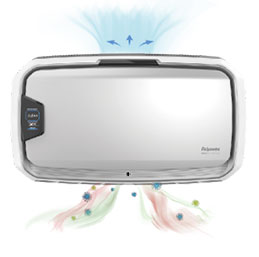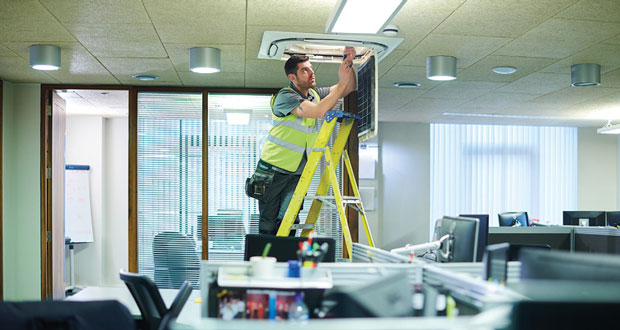Tim Browning, Head of Business Development – Air Treatment at Fellowes explains how air purification systems can help to safeguard against germs and viruses, and could offer wider benefits for the wellbeing of occupants
Even before the pandemic, the government cited air quality as one of the biggest environmental threats to health in the UK. Now, with the added concerns around the airborne transmission of COVID-19, the spotlight on air quality has never been greater. With businesses looking to safely reintroduce staff to the workplace and given the amount of close contact that colleagues can have with each other throughout an average working day, facilities managers should consider incorporating air purification measures into their occupational health strategies.
AIR PURIFICATION IN RESPONSE TO COVID-19
The British Medical Journal (BMJ) explains that when people infected with COVID-19 (or SARS-CoV-2) exhale, particles that include the virus are expelled into the air. If someone is within a “short range” (less than one metre away) they are at risk of inhaling these harmful particles almost instantly. Any remaining particles then disperse and can be inhaled by those further away – and even those over two metres away can be exposed. Particles can remain in the air for hours, so even after the infected person leaves the premises, occupants could still be at risk.
While measures like mask wearing, social distancing and keeping doors and windows open are somewhat effective at reducing the transmission of disease, they are not always practical and are difficult to enforce – especially now that these steps have been removed from government guidance. Moreover, opening a window to access ‘fresh air’ can be rather counterintuitive when you consider the levels of outdoor pollution occupants will be exposed to, especially in cities or sites located near a busy road, or in industrial areas.
To minimise risk further, the BMJ recommends that an air ventilation or air purification system should be installed. This advice has also been underpinned by other organisations globally, including the Centers of Disease Control and Prevention (CDC) and The American Society of Heating, Refrigerating and Air-Conditioning Engineers (ASHRAE).
FURTHER BENEFITS OF AIR PURIFICATION
As well as reducing the transmission of disease, air quality has also been linked to wider health and wellbeing benefits. According to the NHS, ‘sick building syndrome’ poses a real risk to office workers. Poor ventilation and exposure to particles like dust, smoke, fumes and fabric fibres, as well as chemical fumes including volatile organic compounds can cause employees to experience symptoms such as headaches, rashes, coughs, sore eyes or throat, tiredness and difficulty concentrating – which can therefore impact on employee performance and productivity.
In fact, research from Harvard and Syracuse Universities found that employee productivity can be affected by the quality of workspace air. The study found that by improving ventilation and reducing indoor pollutants, cognitive function was vastly increased, with employees performing 61 per cent better on cognitive tasks than in the standard office conditions. It is therefore worthwhile considering how air purification can be implemented as part of a wider wellbeing  strategy to ensure that employees are breathing in clean, purified air.
strategy to ensure that employees are breathing in clean, purified air.
SPECIFICATION OF AIR PURIFIERS
When selecting which air purifiers to install, there are a number of considerations that should be taken into account. Quality models will be able to effectively remove even the smallest particles from the air and here, solutions that are designed with sophisticated filter technology offer the best results and protection. Leading manufacturers have designed air purification systems that feature H13 HEPA technology which can capture hazardous contaminants as small as 0.1 microns, which are easily inhaled and can penetrate deep within the lungs.
Another factor to consider is how often the air is cleaned. Offices are high-traffic premises with employees and visitors accessing numerous spaces and coming into contact with multiple people throughout the average day. Given that COVID-19 and other harmful particles can remain in the air for some time, it is important to select air purifiers that remove contaminants from the air automatically and completely clean the air on a regular basis. Look for models that offer at least five air clean cycles per hour – the equivalent of every 12 minutes.
Finally, for added reassurance that the air purifiers selected can deliver the level of protection needed, check that they have been accredited by an independent third party. For example, certified to neutralise the airborne viral load of SARS-CoV-2, able to remove 99.99 per cent of the aerosolised SARS-CoV-2 virus through a single pass of the purifier and even certified to remove 99.9 per cent of the H1N1 flu virus, commonly known as Swine Flu.
By controlling and cleaning the air to remove airborne germs and viruses (including SARS-CoV-2, the pathogenic virus responsible for the COVID-19 disease pandemic), as well as allergens, odours, gases and chemical fumes including volatile organic compounds, air purifiers are useful for high-traffic spaces like offices.
By focusing on the quality of indoor air as a long-term approach rather than a knee jerk reaction to the pandemic, facilities managers can help prevent the spread of germs and viral infections, while creating an environment focused on wellbeing.





